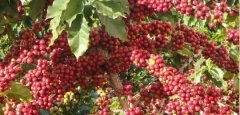Costa Rican coffee beans are classified according to the elevation of coffee estates, the seven largest coffee producing areas in Costa Rica

For professional baristas, please follow the coffee workshop (Wechat official account cafe_style)
Costa Rican coffee has always been considered to be the perfect type of classic flavor, balanced, clean, mild is its tone, has always been known for its extremely balanced, extremely clean, extremely clear, berry-flavored fruit acid. One of the most famous and largest growing areas is Tarrazu, which has the highest latitude and the best climate and soil conditions in Costa Rica, so Tarrazu is recognized as the best coffee producing area. In addition to the near-perfect classic flavor, there is a lively citrus or berry flavor in the acidity, while there will be a significant coffee flower aroma in the finish. It is a quiet coffee full of Latin spring breeze.
Costa Rica is located in the Central American isthmus, and is simultaneously regulated by Pacific and Atlantic currents and sea breezes. There are many towering volcanoes up to 2000 meters above sea level in Costa Rica. Coffee berries grow slowly in the fertile volcanic ash soil and cool environment at high altitude, giving birth to coffee beans with complete and rich flavor. Costa Rica first cultivated coffee on the slopes of the Poas and Barva volcanoes, today known as the Central Valley (Central Valley), and after years of development, there are now seven major coffee-growing areas.
1.Tarrazu (Tarazhu); altitude 1300-2000m.
2.Tres Rios (Sanshui River); elevation 1400-1800m.
3.West Valley (western valley); 1200-1650m above sea level.
4.Central Valley (Central Valley); altitude 1200-1600m.
5.Orosi, 900-1200 m above sea level.
6.Brunca (Blanca); 800-1200 m above sea level.
7.Turrialba (Chuliaba); 600-900m above sea level.
The classification of Costa Rican coffee beans is quite simple, according to the elevation of the coffee garden, a total of seven grades / names / abbreviations / elevations (feet):
1 extremely hard beans (SHB) more than 4500.
2 hard beans (HB) 4000 Murray 4500.
3 semi-hard beans (SH) 3500 Murray 4000.
4 Super high-grade washed beans (EPW) 3000murmur3500.
5 Superior washed beans (PW) 2500 Murray 3000
6 Super good washed beans (EGW) 2000 Murray 2500.
7 good washed beans (GW) below 2000.
In recent years, micro-processing plants have been set up one after another, and since the water consumption is only 5% of that of traditional washing plants, and does not require huge sinks and exposure fields, the investment required is relatively small. The "honey-treated coffee" with low acidity, high complexity and strong sweetness has become the target of competition in the coffee industry in recent years, and the outstanding ones have greatly enhanced the international popularity of the estates.
The characteristics of honey-treated coffee depend to a high extent on the setting of the pulp scraping machine-the more pulp you retain, the more obvious the characteristics of honey treatment. It may be the microclimatic conditions of the location of the processing plant (sunshine / rainfall probability / air humidity), or the ability of the processor, or it may be purely the preference of the processor. Even coffee, also known as "Honey Coffee", has varying degrees of honey-treated features.
White honey treatment is a honey processing method with lower fermentation. Compared with other colors (yellow, red and black), there are more stirring times and less flesh retention in the process of treatment. After drying on the scaffolding, the raw beans with pulp are assembled into pieces and mixed with a little bean shell (sheep skin) to reduce the viscosity and moisture of the berries. So that the sheller can smoothly remove the pulp layer and shell that remain in the outer layer.
Important Notice :
前街咖啡 FrontStreet Coffee has moved to new addredd:
FrontStreet Coffee Address: 315,Donghua East Road,GuangZhou
Tel:020 38364473
- Prev

Introduction to the flavor and taste of coffee beans from Hiriga processing plant in Nyeri, Kenya
Professional baristas please follow the Coffee Workshop (Wechat official account qianjiecoffee) Kenya is a country that produces fine coffee. Only the traditional Arabica was introduced from Britain in 1900, and it was not until 1950 that the best bourbon variants of SL28 and SL34 in Kenya emerged. Most of the coffee beans are graded by the Kenya Coffee Agency and then at auction.
- Next

Introduction to the History of Coffee planting and Coffee Manor in Costa Rica the meaning of FANCY Certification and SHB
Professional barista communication please follow the coffee workshop (Wechat official account cafe_style) Today we are going to talk about Costa Rica. Costa Rica is an important producing country in Central America, among which Tarazhu is a well-known producing area. In modern times, with the vigorous development of the coffee industry, I think there is less and less coffee in a certain country.
Related
- Detailed explanation of Jadeite planting Land in Panamanian Jadeite Manor introduction to the grading system of Jadeite competitive bidding, Red bid, Green bid and Rose Summer
- Story of Coffee planting in Brenka region of Costa Rica Stonehenge Manor anaerobic heavy honey treatment of flavor mouth
- What's on the barrel of Blue Mountain Coffee beans?
- Can American coffee also pull flowers? How to use hot American style to pull out a good-looking pattern?
- Can you make a cold extract with coffee beans? What is the right proportion for cold-extracted coffee formula?
- Indonesian PWN Gold Mandrine Coffee Origin Features Flavor How to Chong? Mandolin coffee is American.
- A brief introduction to the flavor characteristics of Brazilian yellow bourbon coffee beans
- What is the effect of different water quality on the flavor of cold-extracted coffee? What kind of water is best for brewing coffee?
- Why do you think of Rose Summer whenever you mention Panamanian coffee?
- Introduction to the characteristics of authentic blue mountain coffee bean producing areas? What is the CIB Coffee Authority in Jamaica?

